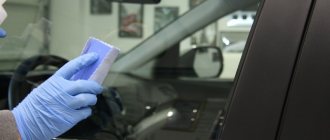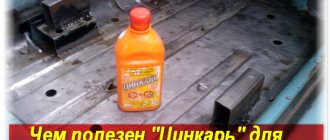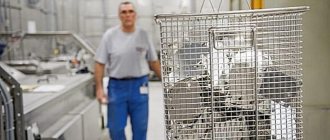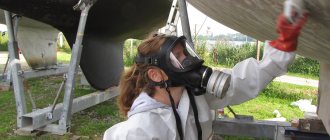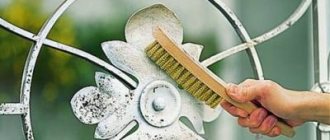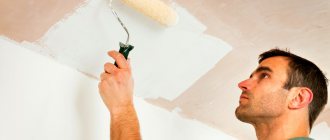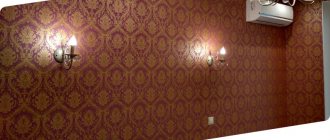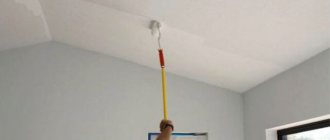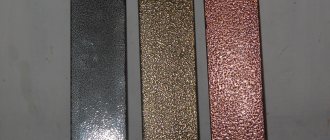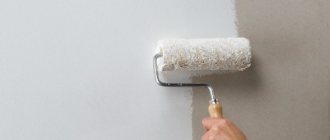The need to prepare metal products for painting is due to an increase in the adhesion characteristics of the substrate to the paint and varnish material and the resistance of the metal to corrosion processes. All this will have a positive effect on the service life of the painted products. However, most owners are much more concerned about the presence of rust, which must be removed during the metal preparation process, than about degreasing, which is why painting work is carried out without this important and mandatory operation.
Types of rust
Metal corrosion occurs:
- Depending on the ongoing process: chemical and electrochemical.
- By type of destruction: uniform and uneven (local).
- Depending on the corrosive environment: atmospheric, soil, gas, liquid (alkaline, acidic or saline).
The choice of rust treatment technology depends on the degree of corrosion damage, which is classified as follows:
- Superficial spots of shallow depth.
- Small points of deep penetration. At subsequent stages, they lead to the appearance of through damage.
- Through penetration.
- Under-film rust, causing local swelling of the paint coating. It is considered the most dangerous, as it leads to the destruction of metal.
Corrosion is classified according to the degree of damage to steel as follows:
- Corrosion stains: characterized by shallow penetration depth. Such corrosion spreads broadly, not deep into the iron.
- Pitting is small spots that penetrate deep into the body of a material. With further development of pitting corrosion, through holes appear on the steel.
- Through corrosion is through damage to the material.
- Under-film corrosion: pockets of rust form under the surface of the coating. Layers of paint in places where rust has formed swell. But sometimes subfilm corrosion remains unnoticed until the steel undergoes complete destruction.
Material processing
Treating the material against rust before painting can be done using the following methods:
- mechanical;
- chemical;
- thermal.
Mechanical method
The mechanical method of anti-corrosion cleaning using hand tools or special equipment is considered effective and reliable. Wire brushes, grinding and grinding wheels, a hydro-sandblasting device, and a sandblasting installation are used.
Structure of a sandblasting machine
Minor areas of damage are cleaned with wire brushes before painting. The brushes are also suitable for pre-cleaning thick layers of rust and weld seams.
The work is accompanied by the formation of a large amount of dust, which is a significant drawback.
The use of grinding and cleaning wheels gives the best result in terms of the quality of the cleaned surface. Wheels are effective when processing small and medium-sized areas.
An abrasive tool for removing traces of corrosion and cleaning the surface for painting from traces of paint is selected subject to several conditions:
- the hardness of the material being processed should be significantly lower than the hardness of the wheel;
- medium grain size is suitable;
- The diameter of the circle is selected in accordance with the processing area.
Process Features
The disadvantages of using wheels include the high consumption of abrasive tools and the need for skill in such work.
Sandblasting and waterjet cleaning are indispensable when working in hard-to-reach places that cannot be reached with a brush or wheel. The technology allows you to get rid of not only rust, but also carbon deposits, scale, and old paint.
The sandblasting process involves exposing metal to sand jets supplied under pressure. The installation includes a compressor, a container with sand and a gun for supplying abrasive.
When waterjetting or hydrosandblasting, a mixture of abrasive material and water is supplied. Delivery occurs at high, low or ultra-high pressure levels. Low intensity saves material, but after the surface dries, signs of secondary corrosion appear.
High supply pressure almost completely removes all deposits. In some areas, traces of black oxides and durable coating sometimes appear. Ultra-high abrasive supply pressure allows you to obtain an absolutely clean surface.
Both methods are only applicable in production environments.
Metal degreasing
Degreasing of structures is carried out to ensure good adhesion of the metal with the paint and varnish composition and primer.
To degrease metal before painting, in principle, you can use any composition that removes organic substances and fats. But still, it is better to use complex compounds that convert rust into a useful layer and prevent its appearance in the future:
- White Spirit;
- numbered nitro solvents;
- degreaser with complex alcohols;
- kerosene.
It is not recommended to use gasoline as a degreasing agent, since as a result of its exposure, an invisible oil film appears on the surface, which impairs adhesion to the paint.
Degreasing must be carried out in well-ventilated areas with constant air circulation, since the vapors of most chemicals used are very toxic. To avoid poisoning, it is recommended to wear a respirator, work in rubber gloves and safety glasses - if any solvent gets into the eyes, a chemical burn to the mucous membrane cannot be avoided.
Chemical cleaning
Chemical removal of traces of rust is carried out by applying chemical converters. Cleaning metal from corrosion is a labor-intensive process. Khimprom produces three types of chemical cleaning products:
- liquid;
- gel;
- aerosol.
Any rust converter works according to this principle. The main active ingredient of the product is phosphoric acid. After application, the acid actively interacts with the surface of an impermeable film of microscopic thickness. Thus, access of the oxidizing agent to the surface is blocked, the chemical reaction stops and further destruction of the metal does not occur.
Carrying out work requires strict adherence to safety rules and manufacturer’s recommendations for the use of the product.
Chemical categories
Washable - after treatment with them, the metal should be washed, dried well and an anti-corrosion compound applied.
Otherwise, new signs of corrosion appear after interaction with water.
Indelible or primer-converters - treatment with this type of product does not require subsequent rinsing, which eliminates the reappearance of rust.
Treatment of metal with acid neutralizer VSN-1 will help in the fight against rust. Removes traces of corrosion and leaves a protective film on the surface with a spray containing zinc Zinkor-Auto. Berner rust deoxidizer works even on rusty parts. The advantage of anti-corrosion acid gel B-52 is the absence of spreading and active effect on rust.
When preparing a rust converter yourself, mix equal parts of oxalic or citric acid with water. Add a teaspoon of soda to the solution per 1 liter of water. Moisten a soft cloth with the solution and thoroughly wipe the affected areas on the metal surface.
A good result is obtained after treatment with orthophosphoric acid. Apply a 20–30% acid solution to the metal. As a result of a chemical reaction, iron orthophosphate is formed on the surface in the form of a durable protective layer. The effect is enhanced by adding tartaric acid (15 ml per 1 liter) or butyl alcohol (5 ml per 1 liter) to the solution.
Metal that is too rusty is treated with a mixture of vaseline oil and lactic acid (100 ml/50 ml). After application, the composition is wiped off with a rag with Vaseline oil.
Vaseline oil will help fight rust
Popular solvents
How to degrease a metal surface before painting is a pressing question for many owners. To degrease metal surfaces, today you can use not only affordable and time-tested compounds, but also modern solvents.
White spirit
Among degreasers, white spirit is most often used. It looks like a transparent, colorless liquid with a characteristic odor of fuel and lubricants.
It is sold in stores under the name “Nefras-S4” and is available in various modifications. The main reason for its popularity is due to its versatility.
This solvent can easily remove any oils and fats, as well as many organic compounds. It is often used to dilute oil paints, enamels and varnishes. White spirit also has one more positive property - after treating the surface, you do not need to wait for it to dry; you can immediately proceed to applying a primer or paint material. The solvent evaporates very quickly, and this is what gives it superiority over other cleaning compounds.
Solvent 646
This type of degreaser is widely used when preparing for painting. It is a yellowish liquid with a strong characteristic odor. It has a fairly wide range of applications.
With this composition you can not only dilute paints, but also degrease metal surfaces. It is especially effective when you need to remove old layers of paint. Can be used for washing painting equipment and tools.
Best suited for diluting the following types of enamels:
- nitrocellulose NC;
- glypthal GF;
- melaninoamide MPs;
- acrylic;
- epoxy.
When using the degreaser, it is necessary to observe the temperature recommended by the manufacturer from + 5 to + 30 degrees Celsius, while the air humidity should not be higher than 85%. Then, after treatment, the metal surface will acquire a shiny, glossy appearance without stains or streaks.
Please remember that Solvent 646 is a flammable and explosive product. You can work with it only while wearing respiratory, eye and skin protection. When carrying out work indoors, it is necessary to ensure the supply of fresh air through windows and doors or through working exhaust ventilation.
Acetone: classic
Another fairly common metal degreaser. In terms of its composition, it is a transparent liquid with a strong characteristic odor. Excellent for removing oil and grease stains, as well as tar.
Acetone can be used to dilute varnishes, enamels, paints and primers. Sometimes it is added to the composition of some solvents. The main component is alcohol, which is highly volatile.
To protect metal surfaces from corrosion processes, they must be specially treated before applying paint. Dyeing technology requires an operation such as degreasing. It can be performed using various solvents and degreasing compounds.
Among them there are both traditional and more modern and technological ones. The choice of the most suitable composition for degreasing should be made taking into account the nature and scale of the tasks at hand, as well as the purpose of the metal product.
At the same time, it is important not to forget about safety rules during degreasing work. Many formulations are unsafe due to the content of compounds harmful to health. Therefore, when carrying out work indoors, it is necessary to ensure constant access to fresh air. You also need to remember that there are no flammable sources nearby.
Thermal method
Cleaning metal from signs of corrosion is often done thermally. An oxy-acetylene torch is used for heating. The entire rusty surface is treated with a burner. After completing the procedure, old paint, rust and mill scale burn out and are easily removed.
In order to prevent the re-formation of rust, it is recommended to treat metal products with anti-corrosion compounds.
